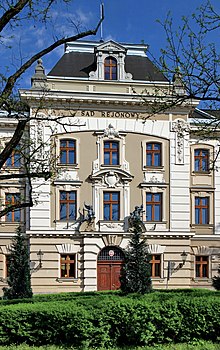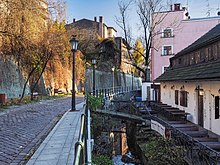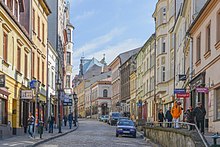Cieszyn
Cieszyn | |
|---|---|
 Cieszyn market square in November 2016 | |
|
UTC+2 (CEST) | |
| Postal code | 43-400 |
| Area code | +48 33 |
| Highways | |
| Voivodeship roads | |
| Website | http://www.cieszyn.pl/ |
Cieszyn (
Geography

The town is situated on the
In 1920 Cieszyn Silesia was divided between the two newly created states of
The town combines both Polish and Old–Austrian peculiarities in the style of its buildings. Because of several major fires and subsequent reconstructions (the last one in the late 18th century), the picturesque old town is sometimes called Little Vienna.[citation needed] The only relic of the ancient castle is a square tower, dating from the 14th century and 11th century romanesque chapel.[citation needed]
History
The area has been populated by West Slavic peoples since at least the 7th century. According to legend, in 810 three sons of a prince – Bolko, Leszko and Cieszko, met here after a long pilgrimage, found a spring, and decided to found a new settlement. They called it Cieszyn, from the words cieszym się ("We're happy"). This well can be found at ulica Trzech Braci ("Three Brothers Street"), just west of the town square.[3][4]

The area became part of the emerging Polish state in the 10th century. The town was the capital of the
The town was divided in July 1920, by the
Cieszyn and Český Těšín were merged again in October 1938 when Poland annexed the Trans-Olza area together with Český Těšín. Following the joint German-Soviet invasion of Poland, which started World War II in September 1939, Cieszyn was occupied by Germany until 1945. In 1939–1940, the Germans carried out mass arrests of local Poles during the genocidal Intelligenzaktion campaign, and then imprisoned them in a newly established Nazi prison in the town.[9] Many Polish teachers, school principals, priests and activists were deported to concentration camps and murdered there.[10] The Nazi prison had two forced labour subcamps in the town, and two more in nearby Karviná and Konská.[11] The Germans also established a camp for children up to the age of 2-3, where they were beaten, tortured and subjected to medical experiments.[12] Almost the entire Jewish community was murdered by the Nazis.
After World War II, the border between Poland and Czechoslovakia was restored to that of 1920. Most Germans
On 19 July 1970, five firefighters from Cieszyn died when a bridge they were on fell into the Olza River, due to heavy flooding. In 1977, Boguszowice, Gułdowy, Kalembice, Krasna, Mnisztwo, Pastwiska were amalgamated with Cieszyn and Marklowice.
Culture
Since the 18th century Cieszyn Silesia has been an important centre of Polish
Industry
Cieszyn is an important centre of the electromechanical industry. It is also the site of the Olza Cieszyn sweets factory (where the famous
Sites of interest


- Romanesque St. Nicholas' Chapel (Kaplica św. Mikołaja, a rotunda from the 11th century), depicted on the current 20 złotych note.
- Remnants of the Piastdynasty castle
- Piast Castle Tower (Wieża Piastowska, mostly 14th century)
- Gothic St. Mary Magdalene Church (Kościół Marii Magdaleny, 13th century), burial site of the Cieszyn line of the Piast dynasty
- Old Town Square (Rynek)
- bourgeoisie houses (15th–19th centuries)
- Town Hall(Ratusz, early 19th century)
- Former minting house (18th century)
- Lutheran Church of Jesus(18th century)
- Museum of Muzeum Śląska Cieszyńskiego, the first museum in Poland)
- Castle Brewery (Browar Zamkowy, 1846)
- Habsburg Palace in Cieszyn
- Bonifraters Monastery (18th century)
- The Church of Jesus (Kościół Jezusowy), with a baroque tower and statues of the Four Evangelists above the altarthat liven up the plain interior.
- Holy Cross Church
Notable people
- Jiří Třanovský (1592–1637), theologian and composer
- Adam Christian Agricola (1593–1645), evangelical preacher
- theologian
- Friedrich Uhl (1825–1906), journalist, writer
- Jakub Skrobanek (born c. 1835–1910), merchant, banker and mayor of Cieszyn
- Rudolf Ramek (1881–1941), Austrian politician, Chancellor of Austria
- Jan Łysek (1887–1915), writer
- Hermann Heller (1891–1933), jurist
- Viktor Ullmann (1898–1944), Jewish musician
- Max Rostal (1905–1991), violinist and educator
- CDU)
- Richard Pipes (1923–2018), Polish-American historian, Harvard University Professor
- Inge Mahn (born 1943), German sculptor, professor
- Jadwiga Smykowska (1945–2017), artist
- Karol Semik (born 1953), teacher and educator
- biathlete
- Ireneusz Jeleń (born 1981), footballer
- ski jumper
- mixed martial artist and former UFCLight Heavyweight Champion
- Piotr Żyła (born 1987), ski jumper, world champion
- Kacper Sztuka (born 2006), racing driver
Twin towns – sister cities
Gallery
-
Town Hall at the Cieszyn Market Square
-
Townhouses in Cieszyn
-
Rotunda from circa 1180 / St. Nicholas Church
-
14th centuryPiasttower
-
Statue of Saint Florian
-
Monastery, church, and hospital of the Sisters of Saint Elizabeth
-
Mary Magdalene Dominican Church, begun in late 13th century
-
Hunting Palace of the Habsburgsand monument commemorating Silesian legionnaries fallen for Poland
-
Hotel on the town square
-
Evangelical Protestant Church of Jesus, begun in 1710
-
Communal Cemetery in Cieszyn
-
Museum of the Cieszyn Silesia
References
- ^ a b "Local Data Bank". Statistics Poland. Retrieved 2022-07-27. Data for territorial unit 2403011.
- ISBN 0-415-93921-6.
- ^ "Cieszyn - Tourism | Tourist Information - Cieszyn, Poland". Staypoland.com. Retrieved 2013-07-16.
- ^ The legend is inscribed on the Well of the Three Brothers[permanent dead link] in Cieszyn.
- ^ Wawreczka et al. 1999, 13.
- ^ Václav Davídek, “Osidlení Tešinska Valahy”, Praha, 1940
- ^ Wawreczka et al. 1999, 10.
- ^ Dzieje Cieszyna..., 2010, t. III, p. 323
- ^ Wardzyńska, Maria (2009). Był rok 1939. Operacja niemieckiej policji bezpieczeństwa w Polsce. Intelligenzaktion (in Polish). Warszawa: IPN. p. 139.
- ^ Wardzyńska, pp. 137–141
- ^ "Strafgefängnis und Stammlager Teschen". Bundesarchiv.de (in German). Retrieved 16 October 2023.
- Biblioteka Jagiellońska. p. 58.
- ^ Dzieje Cieszyna..., 2010, t. III, p. 439–440
- ^ . Encyclopædia Britannica. Vol. 26 (11th ed.). 1911.
- ^ "Miasta partnerskie". cieszyn.pl (in Polish). Cieszyn. Retrieved 2020-03-12.
Further reading
- Chisholm, Hugh, ed. (1911). . Encyclopædia Britannica. Vol. 26 (11th ed.). Cambridge University Press. p. 664.
- ISBN 978-83-927052-6-0.
- Wawreczka, Henryk; ISBN 80-238-4804-6.
- ISBN 83-85831-03-7.
External links
![]() Media related to Cieszyn at Wikimedia Commons
Media related to Cieszyn at Wikimedia Commons
- Official website
- Museum of Cieszyn Silesia (Muzeum Śląska Cieszyńskiego)
- Jewish Community in Cieszyn on Virtual Shtetl















